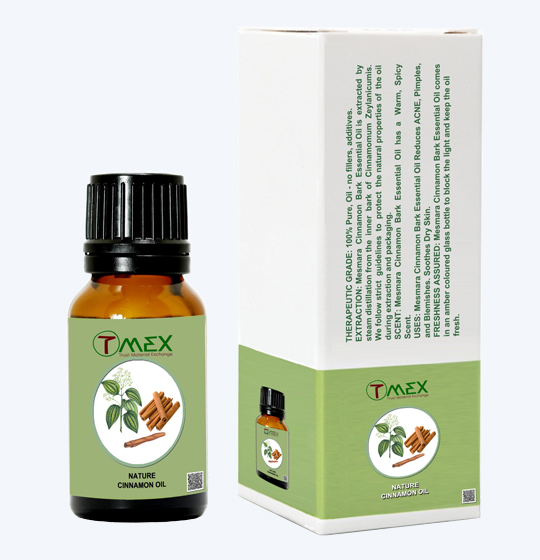
+ Cinnamon Powder: Smoothly, best quality, Color: natural brown, Moisture: ( 13% max), Mesh size 60-80: 90% min, Oil >=0.5%
Packaging: 13 tons in 20FCL/ 25tons in 40FCL.
+ Cinnamon Powder: Smoothly, best quality, Color: natural brown, Moisture: ( 13% max), Mesh size 60-80: 90% min, Oil >=0.5%, Packaging: 13 tons in 20FCL/ 25tons in 40FCL.
+ Cinnamon Powder (for food): Smoothly, best quality, Color: natural brown, Moisture: 7-8% ( 13% max), Mesh size 60-80: 90% min, Oil >=2.5%, Packaging: 13 tons in 20FCL/ 25tons in 40FCL
+ Cinnamon Essential Oil
+ Purity: 85- 90%, Cinnamaldehyde: 80- 92%, Dark brown color, Packaging: in Bottle
1. Plant characteristics and distribution
Wood trees, 10 - 20m high, smooth bark. The staggered leaves have short, long or slightly
stalked stalks, with 3 arched tendons. White flowers, which grow into clusters in the leaves
or the ends of the branches. Egg-shaped nodules, when ripe, have a smooth purple color. The
whole tree has the aroma of cinnamon. Much grown in northern provinces in Vietnam.
According to new studies, C. cassia is a native cinnamon species of Vietnam that is popularly
grown from the northern provinces to the southern provinces of the Central Region. Localities
growing cinnamon with large areas are: Yen Bai, Quang Nam, Quang Ngai, Thanh Hoa, Nghe An and Quang Ninh.
Vietnamese cinnamon species..
2. Growing cinnamon and exploitation
Particles split seeds. Sowing seeds in culture, when young people are strong at 0.6 - 0.7m, they are poor. After 10 years,
in year maybe exploitation 2 times. The first: Apr-May The second: Sep-Oct In Vietnam in the years 1935-1939 exported 1000 - 1,500
tons of cinnamon bark. Currently the statistics are not yet available but the amount of cinnamon bark exported can reach thousands
of tons and the amount of essential oil can be several tens of tons.
3. Parts used
Cinnamon bark - Cortex Cinnamomi: Cinnamon bark curled into a tubular, 25 - 40cm long, 1.5 - 5cm in diameter, or curved pieces
of 3 - 5cm wide, 1-5mm thick, the outer surface is gray-brown, inner face reddish brown to dark brown, easy to break, reddish brown
face with little fiber. After soaking the water, the cross section clearly shows a hard round ivory white tissue. Fragrant, sweet
spicy.
- Small branch: Cinnamon.
- Cinnamon essential oil - Oleum Cinnamomi Cassiae.
Cinnamon essential oil is distilled from the remainder when processing cinnamon (5-10%) from twigs and leaves. Characteristics of cinnamon bark:
+ Thick cork layer, including 6 - 7 rows of cells.
+ Hard tissue cells are classified into 5 - 7 rows, continuously or intermittently in soft tissue.
+ In libe there are many fibers.
+ Many cells contain essential oils in soft tissue and libe.
Cinnamon powder is characterized by fibers, hard tissue cells, soft tissue containing starch and cali oxalate needle-shaped.
4. Chemical composition
Cinnamon bark: - Essential oils 1-3%, can reach 6% (Quang Nam Cinnamon), DĐVN III is regulated not less than 1%.
- Diterpenoid compounds (cinnacassiol), phenylglycosides, mucus, flavonoid compounds, tannins and coumarin. Cinnamon essential oil,
product name Cassia oil, is colorless liquid to yellowish brown, fragrant, sweet after hot spicy, d20: 1,040 - 1,072, nD20: 1,590 - 1,610, D20: - 10 to + 10.
The main part of cinnamon bark essential oil is cinnamic aldehyd (70-95%). VNVN III regulates not less than 85%. There are also cinnamylacetat
- substances that reduce the value of cinnamon essential oil, cinamylalcol and coumarin.
Leaves:
- Essential oil: 0.14 - 1.04%. Analysis of Yen Bai cinnamon leaf oil by resonant spectroscopy from carbon-13 nucleus identified 5
components: Banzaldehyd, bazylacetate, cinnamic aldehyd, cinnamylacetat and coumarin. Cinnamic aldehyd content fluctuates in 12 months in the
year from 34.65 to 95.55%. The lowest is in June and the following months (July, August, September: 57.74%, 69.16%, 82.43%). In contrast,
cinnamylacetat content was highest in June (57.933%) and remained significant during the summer months. From October until mid-May 5 cinnamic
aldehyd content in leaves always reaches over 80%. So if exploiting the shell oil in combination with the leaves should be exploited before
May and after September.
5. Pharmacological and utility uses
- Cinnamon is a precious medicinal herbs used both in Western medicine and Oriental medicine. Cinnamon has the effect of stimulating
digestion, respiratory and circulatory support, increasing excretion, vasoconstriction, increasing intestinal motility and uterine
contraction. According to new studies, cinnamon also has anti-tumor effects, anti-coronary atherosclerosis, anti-oxidation. In Western
medicine used in the form of tincture, medicinal alcohol, liqueur.
- Cinnamon also used a lot to make spices. On the one hand, the taste of cinnamon stimulates eating, stimulates digestion, on the
other hand, because cinnamon has the effect of inhibiting the growth of mushrooms, protecting food from rotten. At a concentration of
1% cinnamon powder has the effect of inhibiting the growth of Aspergilus flavus and concentration of 0.25 - 0.5% inhibiting the formation
of aflatoxin. Oriental medicine places cinnamon in tonic. Characteristics: Sweet spicy, great heat. Effects on all 5 sutras: Mind, waste,
kidney, can, spleen. Has the effect of being a fire-fighting subject, clearing arteries except for welding. Used to rehabilitate the
positive and negative effects of the fire, the organ is cold, poor digestion, abdominal pain. In Eastern medicine, he used cinnamon to
treat colds without sweating, low numbness, and painful limbs. Cinnamon essential oil has antiseptic effect, stimulates digestion,
stimulates the nervous system to ease breathing and circulation, stimulates intestinal motility, is used in combination with other drugs
in the form of alcohol, alcohol sweet and ruby oil.